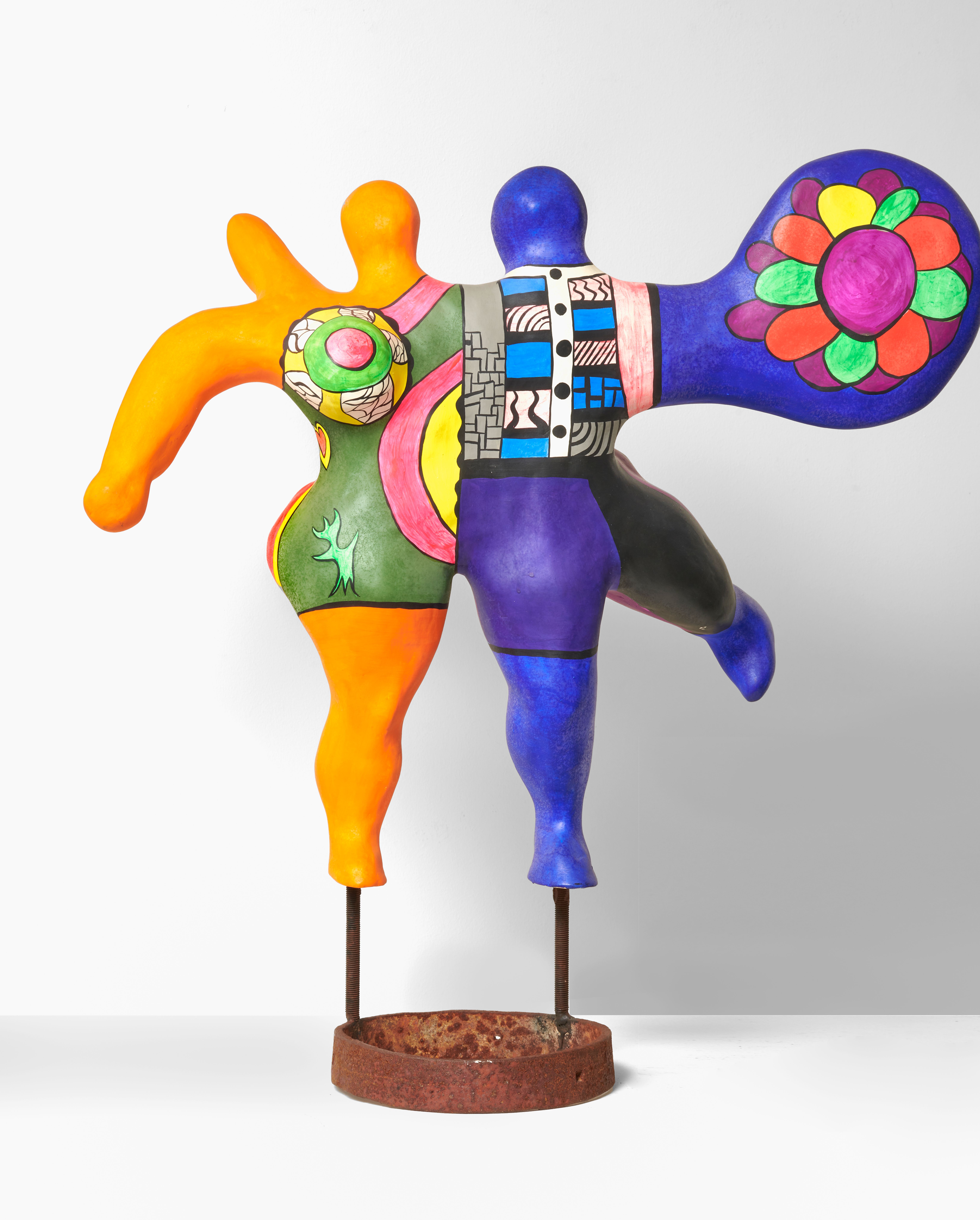Niki de Saint Phalle
Les patineurs - Couple ailé
, 1971Self-taught artist Niki de Saint Phalle caught the attention of the French art scene and popular press in February 1961 when she staged her first Tirs (Shooting Paintings). Her unorthodox approach consisted of creating assemblages on wooden boards with items such as clothing, toys, tools, chicken wire and plaster embedded with paint-filled plastic bags. The constructions, initially painted white, were then shot at by Saint Phalle and others with a rifle, causing the bags to burst and subsequently cover her ‘assassinated’ paintings with splashes of colour. As the artist (who had suffered abuse when growing up) later explained, ‘I was shooting at myself, society with its INJUSTICES. I was shooting at my own violence and the VIOLENCE of the times’ (quoted in Niki de Saint Phalle and Camille Morineau, Niki de Saint Phalle 1930-2002, 2014).
The legendary Tirs paintings, one of which was donated by the artist to Moderna Museet, Stockholm (Tableau tir, 1961, paint, plastic, twine, metal, and plaster, 258 x 155 cm, NMSK 2134), would eventually pave the way for another celebrated group of works by Saint Phalle, her Nanas. Lily Goldberg (Collection Specialist, Department of Painting and Sculpture at MoMA, Museum of Modern Art, New York, NY, U.S.A.) writes (in ‘Niki de Saint Phalle. French and American, 1930-2002’):
Saint Phalle soon expanded this practice to shooting at sculptures, including a reproduction of the classical Greek statue Venus de Milo and forms of her own creation, often reproductions of women. She continued this turn to the sculptural, shifting form from the violence of the Shooting Paintings to a joyful celebration of the female form. Her Nanas, a French slang for girls, are brightly coloured and patterned sculptures of women in action. They dance, run, somersault, dive and leap; according to Saint Phalle, they are provocative in their own right. ‘I thought beforehand that to be provocative, you had to attack religion or generals,’ she has said. ‘I realised that there was nothing more shocking that joy.’
The Nanas (as pointed out above, a familiar, mildly rude French term for a girl or young saucy woman) radically changed Saint Phalle’s way of depicting women: from sad, melancholic, and passive characters to cheerful, energetic, and powerful figures. It was in 1964 that Saint Phalle created the first of what would become an extensive population of Nanas, large-scale sculptures painted in bright colours, representing voluptuous women who portrayed femininity and motherhood. The artist was inspired by a visit from the wife of the American artist Larry Rivers (1923– 2002), Clarice Rivers, who was then pregnant with her first child.
Saint Phalle made numerous Nanas during her career. Several were also created in response to the African American civil rights movement in the United States (1954–68), a testament to the artist’s belief that all women are goddesses, regardless of colour:
I saw a fat woman on the beach today and she reminded me of a great pagan goddess. Black is different. I have made many black figures in my work. Black Venus, Black Madonna, Black Men, Black Nanas. It has always been an important color for me . . . Black is also me now.
Initially the Nanas were made of papier-mâché and wool, with found objects attached. By 1965, Saint Phalle began to introduce polyester resin to create plumper, more active and more vibrant figures that could also be displayed in parks and other outdoor locations. One celebrated example of the latter could be found in the nine monumental fibre-reinforced plastic sculptures that are part of the 1967 work Le Paradis Fantastique/Fantastic Paradise (a total of 16 pieces by Saint Phalle and Jean Tinguely, gifted by the artists to Moderna Museet in 1971) in central Stockholm.
Les patineurs - Couple ailé is a continuation of the important Nana theme. The sculpture, in which a Nana enjoys the company of a male friend, depicts a pair of ice skaters who appear to melt into each other in their intimate choreography. Characterised by Saint Phalle’s bold colours and playful ornamentation, the well-balanced composition embodies not just a strong and harmonious bond between the two but also emphasises movement. Instead of an arm, the man has (what appears to be) a richly decorated wing, which seems to give the couple impetus and speed. In Les patineurs - Couple ailé we see how Saint Phalle’s fascination with unrestrained joy (as a form of individual empowerment), connection, movement, and fantasy come to life. It’s a piece that, like much of her oeuvre, combines playfulness and power.
Provenance
Steinfels Art Consulting.
Firestorm Foundation (acquired through the above).
Copyright Firestorm Foundation
